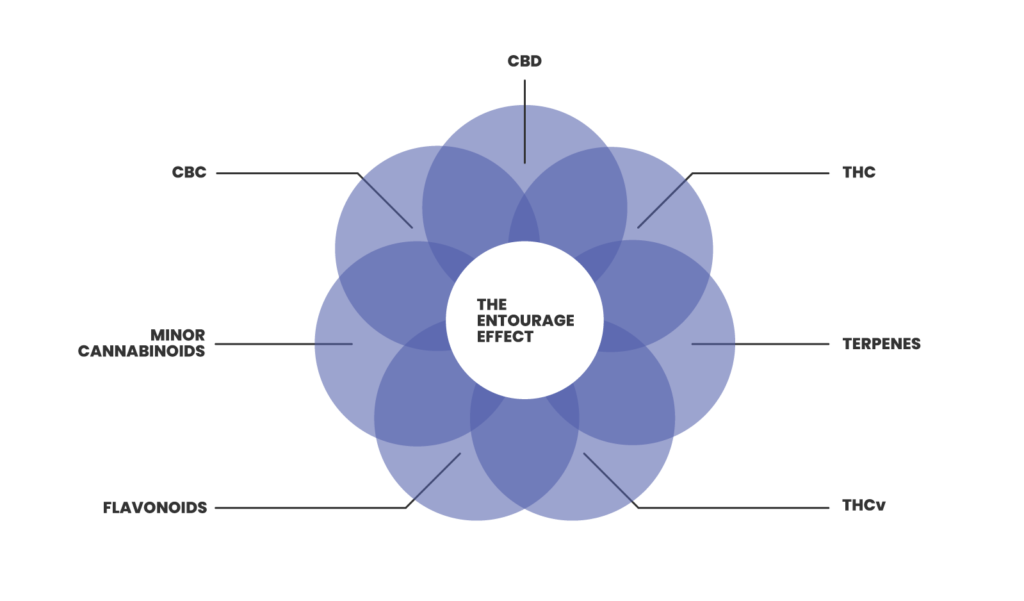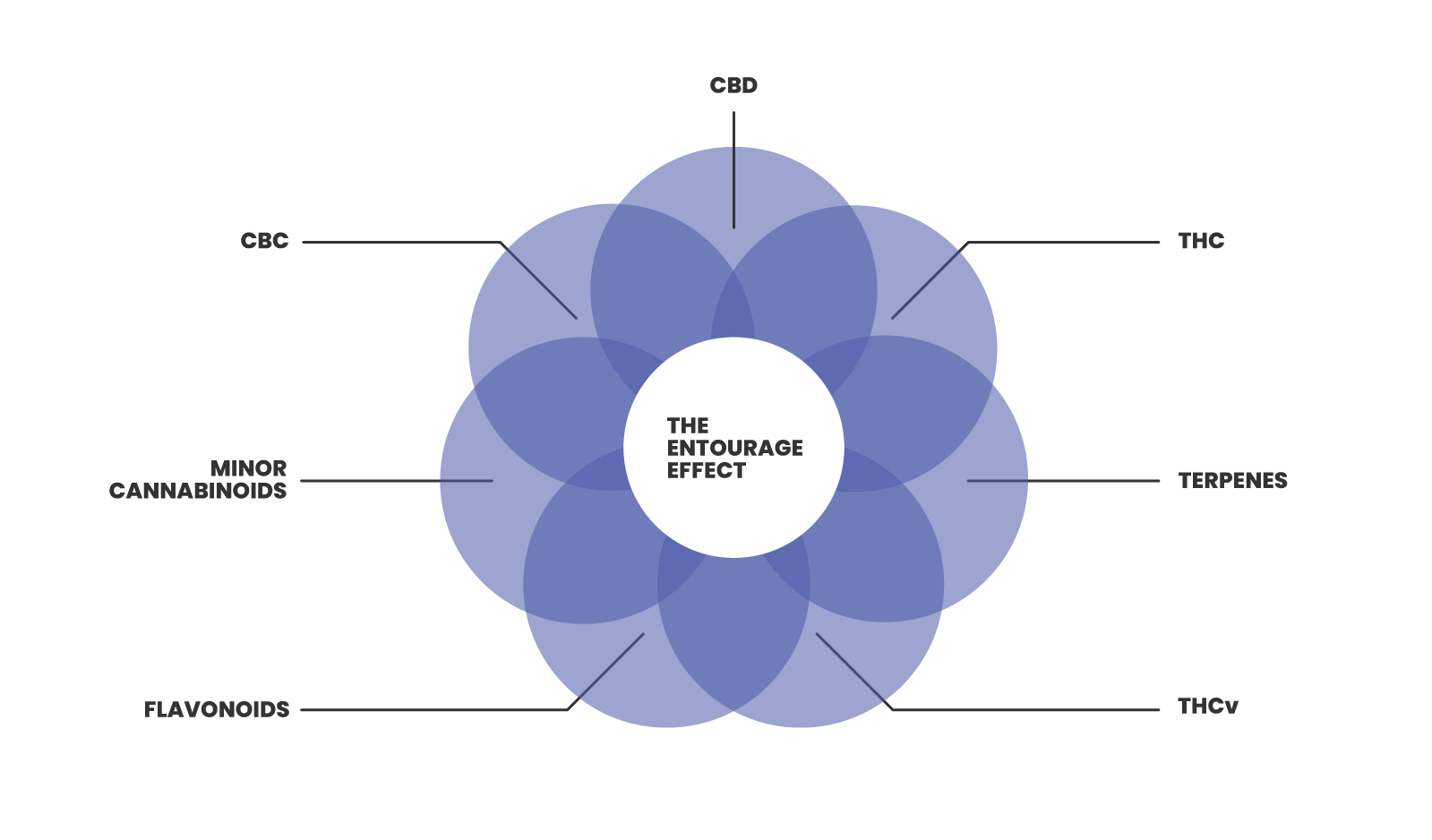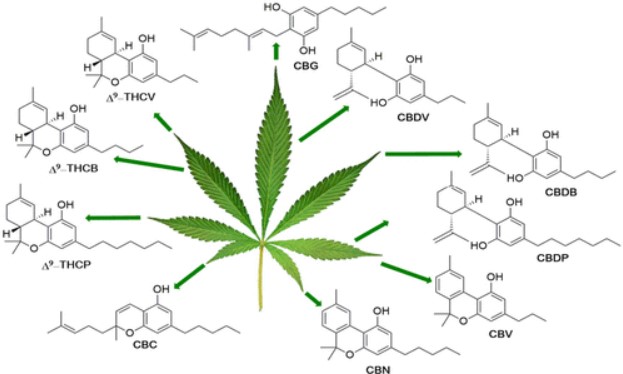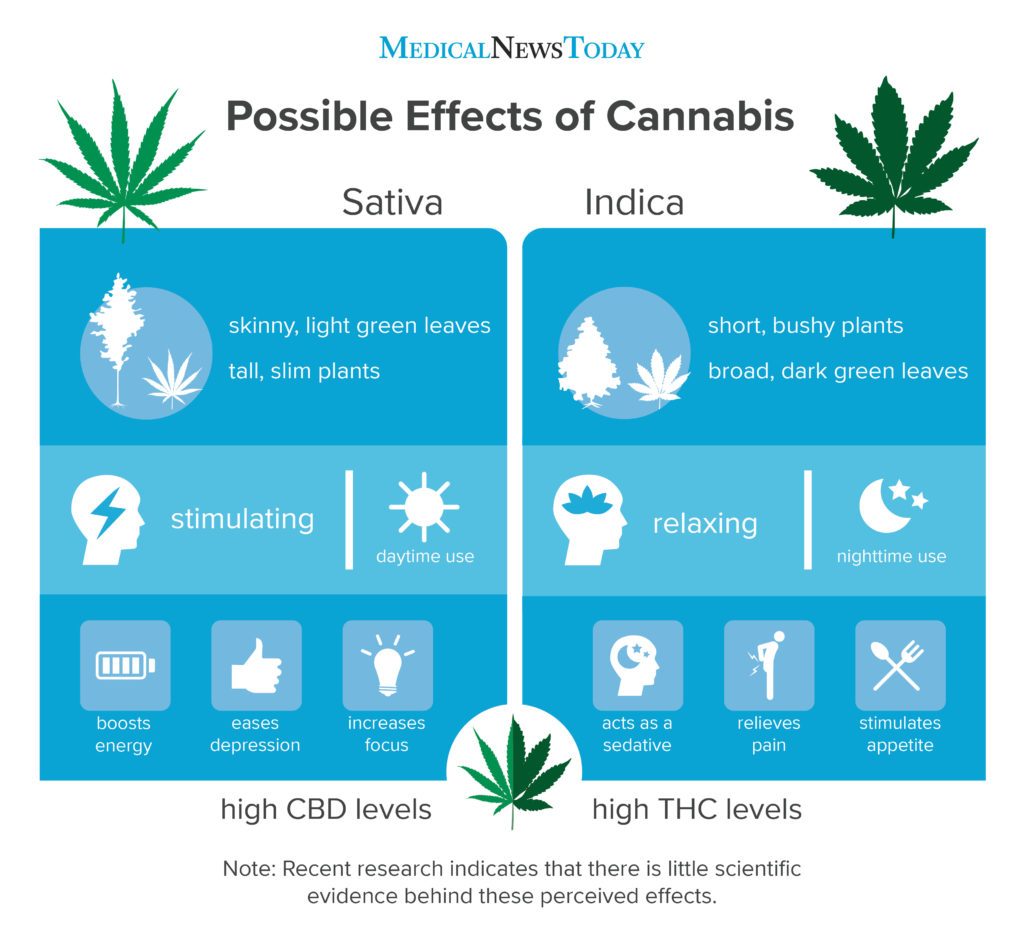Cannabis, a plant renowned for its diverse array of compounds, holds a fascinating secret: the entourage effect. This term encapsulates the synergistic collaboration among cannabinoids, such as THC and CBD, and aromatic terpenes within the cannabis plant. It’s not merely the sum of individual components but rather an intricate dance of compounds enhancing the therapeutic potential of cannabis.
Understanding the entourage effect is pivotal for cannabis consumers, as it unravels the mystery behind the varying effects of different strains. The interplay between cannabinoids and terpenes not only influences the medicinal properties of the plant but also shapes the diverse sensations experienced by users.
In this article, we embark on a journey to demystify the entourage effect, catering to both seasoned enthusiasts and those new to the subject. Through clear explanations and real-world examples, we aim to empower readers with the knowledge to make informed decisions about their cannabis consumption. From exploring the basics of cannabinoids and terpenes to practical considerations in strain selection, we strive to make the entourage effect accessible, fostering a deeper appreciation for the complexity of the cannabis plant.
Table of Contents
Understanding Cannabis Components
What is the The Entourage Effect?
Cannabis Strains and The Entourage Effect
What does the Entourage Effect Feel Like?
Medical Implications of the Entourage Effect
Resources and References
Understanding Cannabis Components
Cannabis, often referred to as marijuana, contains a diverse range of compounds that contribute to its multifaceted effects on the human body. At the forefront of these compounds are cannabinoids, each playing a unique role in shaping the overall cannabis experience.
A. Cannabinoids
Cannabinoids are chemical compounds found within the cannabis plant, interacting with the body’s endocannabinoid system to produce various effects. Here are some key cannabinoids:
- THC (Tetrahydrocannabinol): THC is perhaps the most well-known cannabinoid and is responsible for the psychoactive effects commonly associated with cannabis consumption. It binds to receptors in the brain and nervous system, leading to the euphoric “high” that users experience.
- CBD (Cannabidiol): In contrast to THC, CBD is non-psychoactive and is renowned for its potential therapeutic benefits. It interacts with the endocannabinoid system in a way that doesn’t produce a “high” but may offer relief from anxiety, pain, and inflammation.
- Other Cannabinoids (CBG, CBC, etc.): Beyond THC and CBD, the cannabis plant boasts a myriad of lesser-known cannabinoids, each with its potential effects and benefits. Cannabigerol (CBG), for instance, shows promise in its anti-inflammatory properties, while Cannabichromene (CBC) is believed to contribute to the entourage effect by enhancing the overall impact of other cannabinoids.
Understanding the distinct roles and effects of these cannabinoids is fundamental for consumers seeking specific therapeutic outcomes or looking to tailor their cannabis experience to their preferences. As we delve deeper into the entourage effect, the synergy between these cannabinoids and other compounds will become more apparent, further enriching our understanding of the cannabis plant’s complexities.
B. Terpenes
Terpenes, aromatic compounds found in various plants, play a pivotal role in the cannabis experience by contributing to its distinct flavors and scents. In addition to their sensory aspects, terpenes interact synergistically with cannabinoids, shaping the overall effects of cannabis.
Definition and Role:
Terpenes are organic compounds produced by a variety of plants, including cannabis. These molecules are responsible for the characteristic scents and flavors associated with different strains. Beyond their sensory appeal, terpenes are believed to influence the therapeutic effects of cannabis by interacting with cannabinoids in what is known as the entourage effect. This interaction can modify the overall impact of cannabinoids, potentially enhancing or mitigating certain effects.
Common Terpenes Found in Cannabis:
Understanding the terpene profile of a cannabis strain provides valuable insights into its potential effects and flavors. As we explore the entourage effect, the collaboration between cannabinoids and terpenes will become evident, showcasing the intricate nature of the cannabis plant and the personalized experience it offers to consumers.
The Entourage Effect

A. Concept and Origins
The phenomenon that several substances work together to achieve an effect that they could not achieve alone is called the entourage effect. Such an accompanying effect is therefore more than the net sum of the effects that the substances can have individually. It is the interaction of the compounds that enhances the resulting effect.
More specifically, when substances act in synergy (in mutual dependence), the effect of one substance may be more pronounced while the effect of another may be weakened.The entourage effect, a pivotal concept in the world of cannabis, refers to the intricate synergy among the diverse array of compounds within the plant, working in concert to produce a unique and amplified effect. The origins of this concept lie in the recognition that the therapeutic impact of cannabis is not solely attributed to individual cannabinoids like THC or CBD but rather emerges from the collaborative dance of cannabinoids, terpenes, and other compounds.
The concept gained prominence as researchers and cannabis enthusiasts delved deeper into understanding why different strains, each with its unique combination of cannabinoids and terpenes, elicited distinct effects. It became evident that the combined action of these compounds created a more profound and nuanced experience than what could be achieved by isolated components.
As modern research continues to unveil the molecular intricacies of cannabis, the entourage effect has become a guiding principle in the cultivation and consumption of cannabis. The understanding that the therapeutic potential of cannabis is maximized when its compounds work synergistically has significant implications for medical and recreational users alike.
B. Synergy Between Cannabinoids and Terpenes
At the heart of the entourage effect lies the harmonious synergy between cannabinoids and terpenes. Understanding how these compounds collaborate provides a deeper insight into the diverse and nuanced effects that cannabis can produce.
1. Cannabinoids and Their Roles:
- THC (Tetrahydrocannabinol): THC, the primary psychoactive cannabinoid in cannabis, induces the euphoric sensation commonly associated with marijuana. In the entourage effect, THC’s psychoactive potential is modulated by other cannabinoids and terpenes, potentially mitigating anxiety or enhancing relaxation.
- CBD (Cannabidiol): CBD, known for its non-psychoactive properties, complements THC by offering potential therapeutic benefits without the intoxicating effects. The entourage effect suggests that the presence of CBD may alter the overall impact of THC, influencing the balance between relaxation and alertness.
- Other Cannabinoids (CBG, CBC, etc.): Lesser-known cannabinoids, such as CBG and CBC, contribute their unique properties to the entourage effect. Their presence, even in smaller concentrations, can modify the overall experience by interacting with receptors in the endocannabinoid system.
2. Terpenes as Modulators:
- Myrcene: Myrcene, with its relaxing properties, may enhance the sedative effects of certain strains when combined with cannabinoids like THC. This terpene is often found in indica-dominant strains, contributing to the calming “body high.”
- Limonene: Limonene’s mood-enhancing and anti-anxiety properties can potentially counteract the sedative effects of myrcene. When paired with cannabinoids like CBD, strains rich in limonene may offer a more uplifting and energetic experience.
- Pinene: Pinene, with its alertness-boosting characteristics, may complement cannabinoids like THC to create a more balanced and focused high. Strains high in pinene are often associated with increased creativity and mental clarity.
- Caryophyllene: Caryophyllene, with its anti-inflammatory properties, not only contributes to the entourage effect by interacting with cannabinoids but may also provide therapeutic benefits on its own. Its presence can potentially enhance the overall pain-relieving effects of certain strains.
Understanding how cannabinoids and terpenes interact allows consumers to make more informed choices based on their desired effects. The entourage effect is a testament to the complexity of the cannabis plant and the personalized experiences it can offer.
Cannabis Terpenes Chart with Medicinal uses
| Terpene | Flavor Profile | Effects | Medicinal Uses |
|---|---|---|---|
| Myrcene | Earthy, musky, herbal | Sedative, relaxing, calming | Sleep aid, muscle relaxant, anti-inflammatory |
| Limonene | Citrus, lemon | Uplifting, energizing, anti-anxiety | Stress relief, mood enhancement, anti-depressant |
| Pinene | Pine, woodsy | Alertness, memory retention, anti-inflammatory | Bronchodilator, anti-inflammatory |
| Caryophyllene | Spicy, peppery | Anti-anxiety, anti-depressant, anti-inflammatory | Pain relief, anti-inflammatory, stress reduction |
| Humulene | Earthy, woody, herbal | Appetite suppressant, anti-inflammatory | Weight loss, anti-inflammatory |
| Linalool | Floral, lavender | Relaxing, calming, anti-anxiety | Sleep aid, anxiety relief, anti-depressant |
| Terpinolene | Floral, herbal, fruity | Uplifting, antioxidant, anti-insomnia | Anti-cancer, antioxidant |
| Ocimene | Citrus, sweet, tropical | Energizing, anti-fungal, anti-inflammatory | Antifungal, anti-inflammatory |
| Terpineol | Floral, herbal, lilac | Relaxing, antioxidant, anti-anxiety | Antibiotic, antioxidant |
| Phytol | Floral, balsamic | Sedative, antioxidant, anti-inflammatory | Neuroprotective, antioxidant |
| Bisabolol | Floral, sweet, fruity | Relaxing, anti-inflammatory, anti-irritant | Skin conditions, anti-inflammatory |
| Camphene | Herbal, pungent, camphor | Cooling, anti-inflammatory, antioxidant | Cardiovascular health, antioxidant |
| Terpinene | Herbal, sweet, citrus | Antioxidant, anti-bacterial, anti-fungal | Antioxidant, respiratory health |
| Valencene | Sweet, citrus, orange | Uplifting, anti-inflammatory, anti-anxiety | Anti-inflammatory, mood enhancement |
| Eucalyptol | Minty, cooling, camphoraceous | Respiratory aid, mental clarity, anti-inflammatory | Respiratory health, cognitive function |
| Geraniol | Floral, rose, fruity | Anti-anxiety, anti-depressant, anti-inflammatory | Stress relief, mood enhancement, pain relief |
| Pulegone | Minty, herbal, camphoraceous | Memory enhancement, anti-inflammatory | Cognitive function, anti-inflammatory |
| Sabinene | Spicy, citrus, woody | Anti-inflammatory, antioxidant, antimicrobial | Digestive health, antioxidant, antimicrobial |
| Caryophyllene Oxide | Woody, spicy, peppery | Anti-inflammatory, antioxidant, anti-fungal | Pain relief, anti-inflammatory, antifungal |
| Nerolidol | Floral, citrus, woodsy | Sedative, anti-anxiety, antimicrobial | Sleep aid, anxiety relief, antimicrobial |
| Camphor | Strong, aromatic, medicinal | Cooling, anti-inflammatory, respiratory aid | Pain relief, respiratory health |
| Borneol | Earthy, camphoraceous, minty | Calming, anti-inflammatory, analgesic | Stress relief, pain relief, anti-inflammatory |
| Phellandrene | Minty, citrus, herbal | Energizing, appetite suppressant, anti-inflammatory | Focus, weight loss, anti-inflammatory |
| Alpha-Pinene | Pine, fresh, herbal | Alertness, memory enhancement, anti-inflammatory | Bronchodilator, cognitive function, anti-inflammatory |
| Beta-Pinene | Pine, earthy, herbal | Alertness, memory enhancement, anti-inflammatory | Bronchodilator, cognitive function, anti-inflammatory |
| Delta-3-Carene | Sweet, earthy, piney | Energetic, anti-inflammatory, drying agent | Decongestant, anti-inflammatory, drying agent |
| Alpha-Bisabolol | Floral, sweet, fruity | Relaxing, anti-inflammatory, anti-irritant | Skin conditions, anti-inflammatory |
| Alpha-Humulene | Woody, earthy, herbal | Anti-inflammatory, appetite suppressant | Pain relief, weight loss, anti-inflammatory |
| Gamma-Terpinene | Citrus, herbal, sweet | Antioxidant, anti-bacterial, anti-fungal | Antioxidant, respiratory health, antimicrobial |
C. Mechanisms Behind the Entourage Effect
As we delve deeper into the entourage effect, understanding the intricate mechanisms that underlie this phenomenon is crucial. This section explores the biological and chemical processes that occur when cannabinoids and terpenes work in concert, shedding light on why the combined action of these compounds results in a more profound and nuanced cannabis experience.
**1. Receptor Interactions:
- CB1 and CB2 Receptors: Cannabinoids, particularly THC and CBD, exert their effects by interacting with cannabinoid receptors in the endocannabinoid system. THC primarily binds to CB1 receptors in the brain, leading to its psychoactive effects, while CBD has a more complex interaction with both CB1 and CB2 receptors. The entourage effect suggests that the presence of other cannabinoids and terpenes can modulate these interactions, influencing the overall impact on mood, perception, and physiological processes.
- Terpene Receptor Interactions: Terpenes, despite not directly binding to cannabinoid receptors, can influence the entourage effect by interacting with other receptors in the body. For example, some terpenes may interact with neurotransmitter receptors, potentially influencing mood and stress responses.
**2. Enzyme Inhibition and Potentiation:
- Enzymes in the Endocannabinoid System: Enzymes play a crucial role in the breakdown of cannabinoids within the body. The entourage effect suggests that certain cannabinoids and terpenes may inhibit or potentiate these enzymes, affecting the duration and intensity of the cannabis experience. For instance, inhibiting the breakdown of cannabinoids could prolong their therapeutic effects.
**3. Cross-Talk Between Compounds:
- Synergistic Effects: The entourage effect is characterized by the synergistic interplay between cannabinoids and terpenes, where the combined action produces effects that go beyond what each compound could achieve independently. This cross-talk between compounds enhances therapeutic benefits, mitigates side effects, and creates a more nuanced and personalized experience for the consumer.
**4. Dose-Dependent Effects:
- Optimal Ratios: The entourage effect is not a one-size-fits-all phenomenon. It is dose-dependent, meaning that the ratio of cannabinoids and terpenes in a particular strain or product can significantly impact the resulting effects. Finding the optimal ratio for individual preferences and desired outcomes becomes essential for harnessing the full potential of the entourage effect.
Understanding these mechanisms provides a scientific foundation for the entourage effect, emphasizing that the effects of cannabis are not solely determined by individual compounds but by their complex interactions. As we explore the practical implications of the entourage effect in the subsequent sections, this understanding will serve as a guide for consumers seeking a more tailored and enhanced cannabis experience.
Cannabis Strains and The Entourage Effect
A. Indica vs. Sativa
One of the primary considerations for cannabis consumers is the choice between indica and sativa strains. These classifications have traditionally been used to describe the expected effects and growth patterns of different cannabis varieties, although modern hybridization has blurred these distinctions to some extent.
**1. Indica:
- Characteristics: Indica strains are often associated with a more relaxing and sedative experience. They typically have broader leaves and a shorter, bushier stature. Indica plants tend to thrive in cooler climates and have shorter flowering times.
- Effects: Indica strains are renowned for their potential to induce a “body high,” promoting relaxation and relieving physical tension. They are often favored for evening or nighttime use, as they may contribute to a sense of calmness and aid in sleep.
**2. Sativa:
- Characteristics: Sativa strains are recognized for their uplifting and energizing effects. They usually have thinner leaves and a taller, more lanky growth pattern. Sativa plants thrive in warmer climates and often have longer flowering times.
- Effects: Sativa strains are associated with a more cerebral and creative high. They may enhance focus, boost energy levels, and stimulate creativity. Sativa strains are commonly chosen for daytime use, as they are less likely to induce sedation.
**3. Hybrid Strains:
- Characteristics: Hybrid strains are created by crossbreeding indica and sativa plants, aiming to combine the desirable traits of both. Hybridization allows for a broad spectrum of effects and flavors, offering consumers a more tailored and diverse experience.
- Effects: The effects of hybrid strains can vary widely, depending on the specific combination of parent strains. Some hybrids may lean more towards indica effects, providing relaxation and pain relief, while others may exhibit sativa-like characteristics, promoting creativity and sociability.
Understanding the indica vs. sativa distinction serves as a general guide, but it’s important to note that individual strains can exhibit diverse effects even within these categories. Moreover, the entourage effect plays a significant role in influencing the overall experience, making strain selection a nuanced and personalized aspect of cannabis consumption.
What does the Entourage Effect Feel Like
A. Enhanced Therapeutic Benefits
The entourage effect not only contributes to the complexity of the cannabis experience but also enhances the therapeutic potential of the plant. As cannabinoids and terpenes interact synergistically, their combined action can lead to a range of enhanced therapeutic benefits for cannabis consumers.
**1. Pain Relief:
- The entourage effect may amplify the pain-relieving properties of certain strains. While cannabinoids like CBD contribute to anti-inflammatory effects, terpenes such as myrcene and caryophyllene could enhance pain relief by interacting with receptors in the endocannabinoid system.
**2. Stress and Anxiety Reduction:
- Strains rich in specific terpenes, such as limonene and linalool, may offer heightened stress and anxiety relief. The entourage effect suggests that the presence of these terpenes, combined with cannabinoids like CBD, can create a more calming and relaxing experience.
**3. Improved Sleep Quality:
- Indica strains, known for their relaxing effects, may be particularly effective in promoting sleep. The entourage effect in these strains could involve the synergistic action of cannabinoids like THC and terpenes like myrcene, contributing to a more sedative and restful night’s sleep.
**4. Mood Enhancement:
- Terpenes like pinene and limonene, in conjunction with cannabinoids such as THC, may contribute to mood enhancement and increased energy levels. The entourage effect in sativa-dominant strains could potentially create a more uplifting and euphoric experience.
**5. Anti-Inflammatory Properties:
- The entourage effect extends to the anti-inflammatory properties of certain cannabinoids and terpenes. Strains high in CBD, coupled with caryophyllene-rich terpenes, may provide enhanced relief for conditions involving inflammation.
**6. Combating Nausea:
- Some terpenes, such as myrcene and terpinolene, have been associated with anti-nausea effects. When combined with cannabinoids like THC, the entourage effect could amplify these benefits, making certain strains more effective for individuals dealing with nausea.
B. Impact on Mood and Perception
The entourage effect, with its intricate interplay of cannabinoids and terpenes, plays a pivotal role in shaping the emotional and perceptual aspects of the cannabis experience. Understanding how this synergy influences mood and perception is essential for consumers seeking a nuanced and personalized encounter with the plant.
**1. Elevated Mood:
- Certain terpenes, like limonene and pinene, are associated with mood enhancement. When combined with cannabinoids such as THC, these terpenes may contribute to a euphoric and uplifting experience. The entourage effect suggests that the collaboration between these compounds creates a more profound and sustained improvement in mood compared to isolated cannabinoids.
**2. Relaxation and Stress Reduction:
- Indica strains, rich in myrcene and caryophyllene, may provide enhanced relaxation and stress reduction. The entourage effect in these strains could lead to a deeper and more lasting sense of calmness, with myrcene contributing to muscle relaxation and caryophyllene potentially acting on stress response pathways.
**3. Enhanced Creativity:
- Sativa strains, often high in terpenes like terpinolene and pinene, may boost cognitive function and creativity. The entourage effect in these strains could heighten mental clarity and focus, fostering an environment conducive to creative thinking and problem-solving.
**4. Altered Perception of Time:
- The entourage effect’s influence on THC, the primary psychoactive cannabinoid, may alter the perception of time. Strains with a balanced ratio of cannabinoids and terpenes could potentially create a more enjoyable and immersive experience without a distorted sense of time.
**5. Sensory Enhancement:
- Terpenes like myrcene and linalool may contribute to sensory enhancement, affecting taste, smell, and even visual experiences. The entourage effect in strains rich in these terpenes could amplify the enjoyment of sensory stimuli, making activities like eating or appreciating art more pleasurable.
**6. Cognitive Effects:
- The entourage effect’s modulation of cannabinoid receptors in the brain may influence cognitive functions. While THC can induce short-term memory impairment, the presence of other cannabinoids and terpenes may mitigate or intensify these effects, highlighting the importance of strain selection for individuals with specific cognitive considerations.
C. Examples of Reported Experiences
Exploring the entourage effect through reported experiences provides valuable insights into the diversity and nuances of cannabis effects. While individual responses vary, the following examples showcase the range of experiences reported by users, shedding light on how different strains and their unique cannabinoid-terpene profiles can shape the cannabis encounter.
**1. Calm and Relaxation with Indica-Dominant Strains:
- Users often report a profound sense of calm and relaxation with indica-dominant strains, especially those high in myrcene and caryophyllene. The entourage effect in these strains may contribute to muscle relaxation and a gentle sedative effect, making them suitable for winding down in the evening or managing stress.
**2. Uplifting and Energizing Effects with Sativa Strains:
- Sativa-dominant strains, rich in terpenes like limonene and pinene, are frequently associated with an uplifted mood and increased energy. The entourage effect in these strains may enhance cognitive function, making them popular choices for daytime use, creative pursuits, or social activities.
**3. Balanced Experience with Hybrid Strains:
- Hybrid strains, carefully crafted to blend indica and sativa characteristics, offer a balanced experience. Users report a harmonious interplay between the relaxing effects of indica and the energizing qualities of sativa. The entourage effect in hybrids showcases the versatility of cannabis, providing a middle ground suitable for various occasions.
**4. Enhanced Pain Relief and Anti-Inflammatory Effects:
- Individuals seeking pain relief often report enhanced efficacy with strains high in CBD, caryophyllene, and myrcene. The entourage effect in these strains may amplify anti-inflammatory properties, offering potential relief for conditions such as chronic pain, arthritis, or migraines.
**5. Improved Sleep Quality with Myrcene-Rich Strains:
- Strains with elevated levels of myrcene, commonly found in indica varieties, are frequently associated with improved sleep quality. The entourage effect in these strains may contribute to sedative effects, making them appealing to individuals dealing with insomnia or seeking a restful night’s sleep.
**6. Cognitive Clarity and Focus with Terpinolene-Prominent Strains:
- Strains rich in terpinolene, a terpene with potential cognitive-boosting effects, may be linked to enhanced creativity and mental clarity. The entourage effect in these strains may amplify the stimulating properties, making them attractive options for individuals looking to maintain focus during work or creative endeavors.
While these reported experiences provide a glimpse into the entourage effect’s impact, it’s crucial to recognize the subjective nature of cannabis effects. Factors such as individual tolerance, dosage, and personal preferences contribute to the variability in experiences. As we explore the entourage effect further, these examples serve as a foundation for understanding the potential outcomes of different cannabinoid-terpene combinations.
Medical Implications of the Entourage Effect
A. Potential Health Benefits
The entourage effect in cannabis has garnered significant attention for its potential health benefits, making it a focal point for medical cannabis research. The collaborative synergy between cannabinoids and terpenes holds promise for various therapeutic applications.
**1. Pain Management:
- The entourage effect may enhance the analgesic properties of cannabis, offering potential relief for individuals dealing with chronic pain conditions. Strains high in cannabinoids like CBD, combined with myrcene and caryophyllene, may contribute to a more comprehensive pain management approach.
**2. Anti-Inflammatory Effects:
- Conditions involving inflammation, such as arthritis or inflammatory bowel diseases, could benefit from the anti-inflammatory effects of specific cannabinoid-terpene combinations. Research suggests that the entourage effect may amplify the anti-inflammatory properties of cannabinoids like CBD and terpenes like caryophyllene.
**3. Mood Disorders and Anxiety:
- Terpenes such as limonene and linalool, in conjunction with cannabinoids like CBD, may contribute to mood stabilization and anxiety reduction. The entourage effect in strains with these profiles could potentially offer a natural and holistic approach to managing mood disorders.
B. Considerations for Medical Cannabis Patients
For medical cannabis patients, understanding the entourage effect is pivotal in optimizing therapeutic outcomes. Several considerations can guide patients in harnessing the potential benefits while minimizing unwanted effects.
**1. Strain Selection:
- Tailoring strain selection based on the desired therapeutic effects is crucial. Medical cannabis patients may benefit from experimenting with different strains and observing how specific cannabinoid-terpene profiles influence their symptoms.
**2. Dosage and Administration:
- The entourage effect is dose-dependent, emphasizing the importance of finding the right dosage for individual needs. Patients are encouraged to start with low doses and gradually adjust, considering factors such as tolerance and sensitivity.
**3. Consultation with Healthcare Professionals:
- Medical cannabis patients should consult with healthcare professionals to discuss their specific medical conditions and explore the most suitable strains. Professional guidance ensures a more personalized and informed approach to cannabis-based treatments.
C. Research and Studies
The entourage effect’s medical implications have sparked a surge in research endeavors to explore its mechanisms and potential applications. Ongoing studies aim to deepen our understanding of how specific cannabinoid-terpene combinations influence various health conditions.
**1. Cannabinoid and Terpene Combinations:
- Research is focusing on identifying optimal cannabinoid-terpene ratios for specific medical conditions. Understanding how different combinations affect receptors in the endocannabinoid system can pave the way for targeted treatments.
**2. Clinical Trials:
- Clinical trials are underway to assess the efficacy of entourage effect-based treatments for conditions such as chronic pain, epilepsy, and mental health disorders. These trials provide valuable insights into the real-world impact of the entourage effect on patients’ health.
**3. Safety and Side Effects:
- Research is also addressing the safety profile and potential side effects associated with the entourage effect. Comprehensive studies aim to provide a clearer understanding of the risk-benefit profile for medical cannabis patients.
As research in this field progresses, the entourage effect holds considerable promise for expanding the therapeutic arsenal available to medical cannabis patients. By staying informed about the latest developments and consulting with healthcare professionals, patients can navigate the evolving landscape of medical cannabis with a more informed and empowered approach.
Resources and References
A. Books
- “The Cannabis Health Index: Combining the Science of Medical Marijuana with Mindfulness Techniques To Heal 100 Chronic Symptoms and Diseases” by Uwe Blesching:
- A comprehensive resource that explores the medicinal properties of cannabis, including insights into the entourage effect. Blesching combines scientific research with mindfulness techniques to provide a holistic perspective on the potential health benefits of cannabis.
- “The ABC’s of CBD: The Essential Guide for Parents (and regular folks too)” by Shira Adler:
- Adler’s book delves into the therapeutic properties of CBD and its interaction with other cannabis compounds. It offers accessible information for individuals seeking a foundational understanding of cannabinoids and the entourage effect.
B. Scientific Journals
- Journal of Cannabis Research:
- A peer-reviewed journal that publishes research articles, reviews, and commentaries on various aspects of cannabis science. It serves as a valuable resource for staying updated on the latest scientific developments related to cannabinoids, terpenes, and the entourage effect.
- Frontiers in Plant Science – Plant Metabolism and Chemodiversity:
- This scientific journal explores the chemodiversity of plants, including cannabis. Articles within this journal may provide in-depth insights into the biochemical processes underlying the production of cannabinoids and terpenes, contributing to the entourage effect.
C. Online Sources
- Project CBD (https://www.projectcbd.org/):
- An educational website that provides evidence-based information about CBD and the broader cannabis plant. Project CBD offers articles, research updates, and resources, making it a reliable source for individuals seeking information on the entourage effect.
- PubMed – National Library of Medicine (https://pubmed.ncbi.nlm.nih.gov/):
- A comprehensive database of scientific articles and studies. Searching for terms like “cannabinoids,” “terpenes,” and “entourage effect” on PubMed can yield a wealth of peer-reviewed research articles, offering a rigorous and evidence-based understanding of cannabis science.
- Leafly (https://www.leafly.com/):
- A popular online resource that provides information on various cannabis strains, including their cannabinoid and terpene profiles. Leafly’s strain reviews and educational content can aid consumers in selecting strains that align with their preferences and desired effects.
These resources serve as starting points for individuals interested in delving deeper into the science of the entourage effect. It’s crucial to approach information critically, considering the credibility of sources and staying abreast of emerging research in the dynamic field of cannabis science.





